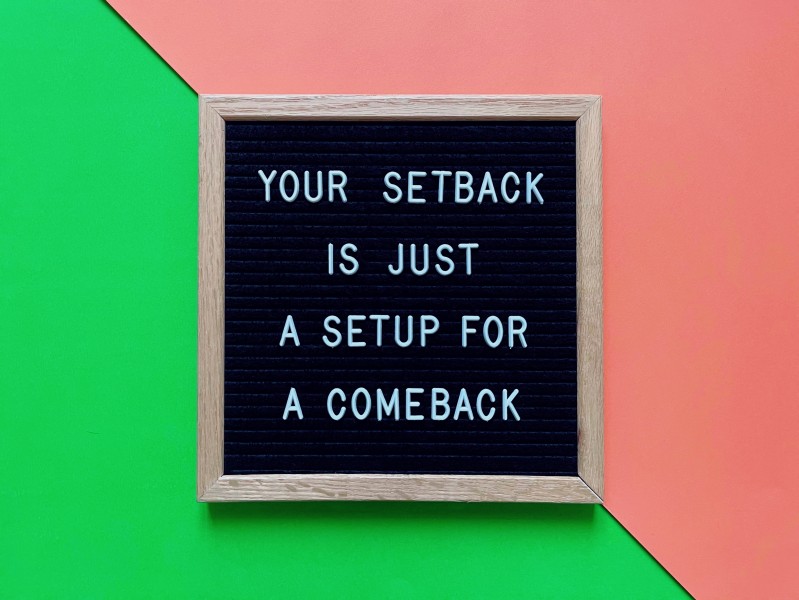Make Your Comeback Greater Than Your Setback: 3 Ways to Pivot With Purpose

We’ve all had setbacks that affected us at work, home, or both at the same time. Perhaps that’s why I’ve always appreciated a great comeback story.
Like Michael Milken, the former financier who went to prison for racketeering and securities fraud, was then released after two years for good behavior and has spent the past 30-plus years on philanthropic ventures that transformed medical research, public health, and education. I also think of movie star Robert Downey Jr., who garnered an Oscar nomination in 1993 but then spent many of the next few years either in jail or in rehab. He eventually got sober in the early 2000s, focused on his career, and was cast as Ironman, star of the iconic Marvel superhero franchise.
However, a comeback doesn’t have to involve rebounding from dramatic events, as these two individuals did. You might be planning how to rise above career disappointments, such as being laid off or not getting your dream job. Perhaps you have felt stuck in your job or industry for years and are now ready to shake things up by exploring a new path that brings you greater fulfillment. In any case, you can make your comeback greater than your setback by pivoting with purpose.
What It Means to Pivot with Purpose
Pivoting with purpose involves making changes in alignment with your goals, values, and beliefs. Instead of taking a haphazard, reactive approach, your shift in direction is both deliberate and intentional.
You honestly assess what works for you now and jettison what doesn’t, being open to change and exploring new directions that can yield more meaning and happiness. The key is staying true to yourself.
That’s what Wendy Parslow has done.
Parslow explains that she experienced a multi-year “career trauma.” It started with a restructuring by her former employer, where she didn’t get the chance to apply for a role while on maternity leave. Feeling like she hit a career ceiling, Parslow expressed the truth of discontent and disappointment. Peers were supportive, recognizing her achievements while validating her concerns. When the company had a reduction in force in January 2023 and she was laid off, Parslow saw it as a gift.
“I had grown so much as a leader during 15 years at that company. I knew I wanted something different in the next half of my career and now had the freedom to take that next step,” explained Parslow.
A few weeks later she landed a new job at a travel startup, joining their executive team to help build at scale. However, the firm encountered some significant challenges and Parslow found herself planning for company layoffs instead of expansion. Within a few months, nearly 50% of the team was let go, including her own leadership role.
“At the end of it, I was grateful for the opportunity because it showed how well my skillset translated to a very different organization while having a seat at the table,” she said. “I was able to influence the trajectory of a company, working alongside the co-founders to make strategic decisions while coaching and supporting them and my team.”
Being laid off twice within four months was hard, especially coming after the difficult time that preceded it. However, that setback mobilized Parslow to gain more clarity about who she is and what she wants in her career.
Today, she is coming back even stronger than before. Parslow founded a networking group for local women’s leaders that is now 200 people strong. Equipped with the understanding of what truly lights her up now, Parslow is actively seeking a job focused on strategic Human Resources leadership while leveraging her tremendous people development and operations leadership experience.
“I’d love to oversee an HR department or part of a department to help align business strategy with people strategy and create positive workplaces for people to work,” she said. “That’s what I’m motivated by, creating great team cultures. I’m known as a team builder to create powerful, effective teams to deliver results.”
Want to make your comeback greater than your setback? Here are a few steps you can take:
1. Choose optimism.
I’m talking about when given the choice between pessimism and optimism, you actively seek the positive. This is different from “toxic positivity” which isn’t based on reality. In this case, you are realistic about seeking the upside during challenging times.
It involves looking for signs of progress and appreciating lessons learned. You acknowledge the struggles while also honoring wins along the way. Choosing optimism opens you up to receiving new opportunities and learning more about yourself. Doing just that has helped Parslow become more resilient.
“I believe that resilience honors the struggle and barriers that were placed in front of you, where optimism is just pure hope, the bright light in a way,” she explained. “Choosing optimism ultimately leads to a series of results and creates more resilience. A few years ago, when I was dealing with that career trauma and that struggle, it just felt so dark and I didn’t see a way through. And this year has been different because I’ve been able to leverage my optimism to drive more resilience, pulling through faster and quicker.”
When I asked what advice about optimism she had for others, Parslow shared a phrase that a former mentee taught her—“What would need to be true for _____ to happen?” She noted that there is a lot of power in this pragmatic statement, which can be used for any issue in business or life.
“All of a sudden it puts your mindset into what’s possible versus what is impossible,” Parslow said. “It is training your brain to be optimistic, and it is forcing you to be creative as well, because optimism thrives in creativity.”
2. Break out of your comfort zone.
Management consultant and author Judith Bardwick coined the phrase comfort zone more than thirty years ago to describe “a behavioral state within which a person operates in an anxiety-neutral condition, using a limited set of behaviors to deliver a steady level of performance, usually without a sense of risk.”
A comfort zone, without any challenges or risks, is a narrow place to be—sure, you’re safe and relaxed, but there isn’t a lot of incentive to shake things up, pursue personal growth, or achieve outstanding results. Things will stay the same because you do, which inhibits a fulfilling comeback.
However, there are numerous benefits to breaking out of your comfort zone. As leadership strategist and personal mastery expert Shadé Zahrai noted, they include becoming more productive, increasing adaptability to change, enhancing creativity, and promoting personal growth. To successfully pivot, you often need to step outside of your comfort zone to see what’s possible, gain new ideas, test your limits, and take calculated risks.
Here is an article I wrote about how to break out of your comfort zone. If you want more information on the topic, check out Andy Molinsky’s great book, Reach: A New Strategy to Help You Step Outside Your Comfort Zone, Rise to the Challenge, and Build Confidence.
3. Strategically refocus.
A successful pivot is often based on recognizing what you do well and refocusing it in a new way. Parslow realized that all her years building operational strategy and positive team cultures directly translated into Human Resources management—an area she is very passionate about.
Once you are clear about your desired career comeback, make a list of the factors that uniquely position you to thrive in that role. Having that clarity allows you to connect with the right people to find the most fulfilling opportunity possible.
How have you successfully planned a comeback after facing a professional setback? What made your transition successful?
Do you have a story to share of how you stay optimistic at work, or bring optimism into the workplace? We want to hear from you! Share your story by commenting on this LinkedIn post here or email us at Shira@shiramiller.com for the opportunity to be featured in a future article.
